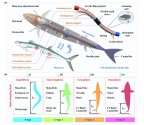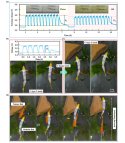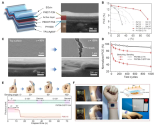Robotic fish driven by bionic muscle can self-adapt four "swimming modes" optimized for different scenarios.
Soft Robotic Fish Actuated by Bionic Muscle With Embedded Sensing for Self-Adaptive Multiple Modes Swimming
Fish can adaptively adjust their body kinematics and swimming modes by sensing to realize optimal propulsion. However, most soft robotic fish have an unchangeable swimming mode through simple structure design, making them difficult to adapt to dynamic and complex fluid environments. Here, inspired by the multiple muscle synergy and lateral line sensing function of fish, we developed a soft robotic fish with multiple actuating units and embedded sensing elements. By collaboratively controlling the amplitude and phase of excitation from the multiple flexible actuating units, the soft robotic fish can successfully realize various swimming modes very similar to those of natural fish. Additionally, the embedded flexible sensing elements enable the robotic fish to sense the swimming state and the surrounding fluid environment in real time. The multiple actuation and embedded sensing allow the soft robotic fish to adaptively switch to an optimal swimming mode in a certain fluid environment. The multimode swimming and perception capabilities proposed in this work not only make soft robotic fish more intelligent and adaptable to complex fluid environments, but also contribute to the future implementation of autonomous control capabilities for robotic fish.
近日,中国科学院沈阳自动化研究所机器人学研究室微纳米课题组设计开发了一款基于仿生肌肉驱动与嵌入式柔性感知的软体机器鱼,相关成果发表于机器人领域Top期刊IEEE Transactions on Robotics(T-RO)。
作为自然界进化了亿万年的产物,鱼类的高效游动行为主要和高灵敏度的侧线感知系统以及高度发达可控的肌肉驱动系统密切相关。
相关研究表明,鱼体两侧的肌肉主要分为白肌和红肌,其中白肌提供爆发力,红肌提供耐力。并且在游动过程中,白肌的响应速度会相对更快。鱼类正是通过感知-驱动系统的协同作用,及时感知周围环境的变化,自适应调整不同部位肌肉的激活强度和次序,进而调整身体的运动学和游动方式实现最优推进。
受此启发,研究人员提出了基于仿生人工肌肉驱动的驱感一体化多模态软体机器鱼设计方法,在多驱动单元协同控制策略、嵌入式柔性感知系统、环境自适应智能切换三个方面取得了突破:
01 协同控制:
机器鱼以鲭鱼为仿生原型,由3D打印的柔性仿生结构和集成多种驱动单元与传感元件的一体化软体驱动器组成。其中,软体驱动器为多层的柱状结构,由压缩弹簧、介电弹性体(DE)薄膜和柔性电极构成。类似鱼类脊柱的压缩弹簧为机器鱼提供支撑,多层柔性薄膜模拟于鱼的肌肉组织,为机器鱼提供形变和动力。
02 柔性感知:
为了模拟鱼类的肌肉侧线系统并实现同步驱动和传感,研究团队提出利用和驱动器相同的本体材料,设计并开发了高精度的柔性应变
并首次集成到机器鱼中,可帮助机器鱼实时感知游动状态和周围流体环境变化,并自适应的切换到最佳的游动模态。
03 环境适应:
通过协同控制多仿生肌肉单元的激励幅值和次序,机器鱼可以成功复现自然鱼类的多种游动模态,并适应不同的游动环境。例如C-type 1模式适合在狭窄空间作业,C-type 2模式适合在水中快速游动,C-type 3模式适合湍流环境,而S-type更适合低雷诺数的粘度环境下游动。机器鱼可以利用嵌入式柔性传感元件实时感知周围环境变化并自适应切换到最佳游动模态实现有效推进。相较同类软体水下机器人,该机器鱼首次实现驱动-感知-控制一体化,具有多种游泳模式数量(4种)与感知能力。






